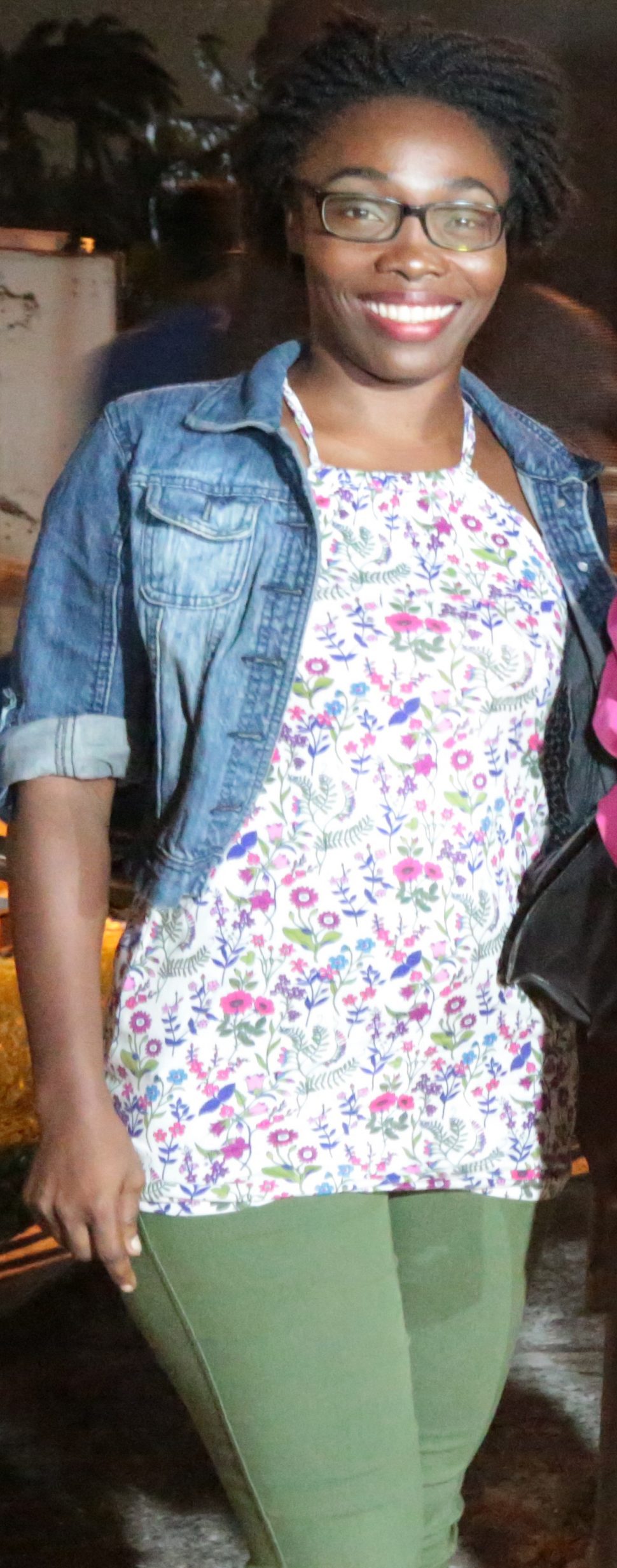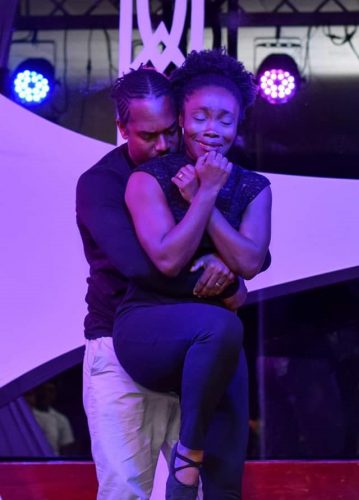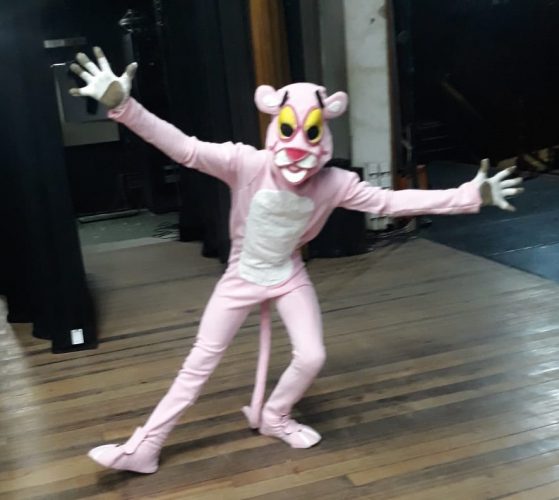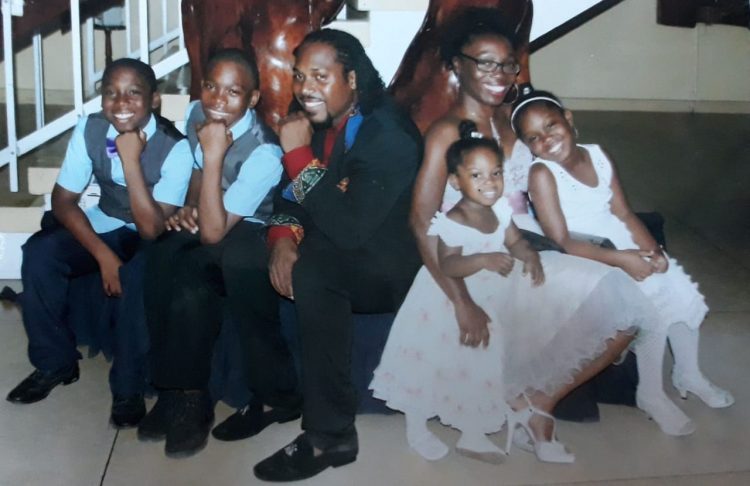Esther Hamer has given 33 years of her life to dance having taken up the art at 4 years old. Though passionate about dance, over the years, Esther has also found herself drawn to other art forms: drama, designing, producing and directing all while being a full-time mother and wife.
“My mother is what I would call a performing arts enthusiast. She likes music, dance, drama and does a bit of knitting and sewing. She got me involved in dance after seeing me wining to the old funeral song that used to play on the radio. After she saw that, she thought to find a dance school and that’s how I got enrolled in the National School of Dance. So, my mother was one of the key factors in pushing me to dance,” Esther explained.
Her father danced too; waltzes and club dancing. He taught Esther to waltz. He was her first dance teacher. He also did portraits. Her sister, Esther said, danced during her primary and high school years but moved on to dressmaking and design. Her sister along with her brother drew really well though they never took it up professionally. Esther’s grandmother on her mother’s side was involved in drama and was also a member of her church choir. So, there was a foundation and reinforcement as regards her life in dancing and the arts.
Esther attended the Bishops’ High School and found herself in the arts stream. She described herself to be “stubborn” back in school and only focusing on the subjects she liked, which were just a few: History, Geography and Social Studies; she hated Mathematics. “I honestly did not like school. It was only because my mother asked me if I wanted to pull donkey cart for the rest of my life. I mean nothing is wrong with those who do that but that was not what I wanted to do so I tried to focus more in school.
“I was more interested in drawing, reading and athletics; long jump was my line. I actually regret not showing interest in some of the things that were offered like music classes when they were free and I had the time,” she shared.
Some of the challenges she faced included having to deal with persons from various backgrounds and being someone who said what she wanted to say whenever she wanted to say it, got her into trouble more than once. She struggled with this in her younger years, today it is not much of an issue anymore. Another was not being as flexible as is required of a dancer; certain routines meant her working harder at her flexibility than a taller dancer would. Now that she is older, it has become more challenging and she has to work harder. Standing out as a woman dancer of African ethnicity is also challenging, Esther said, since there are many other women dancers. Probably the most challenging for Esther is rebuilding her dance techniques after having suffered a back injury ten years ago because of an accident.
“Generally, in theatre and dance they usually tell you to dance with the same energy and facial expressions that you’ll be dancing onstage during rehearsals,” she related. “On this day, I had invited my sister and mother to look on and have their reviews after. I was excited that my family was there to watch. Another dancer and I came out with two pieces of fabric which we had to do Chaînés [a ballet term for a sequence of fast turns from one foot to the other executed in a straight line]. We were supposed to work together, and I got a bit excited and I think she made an error at the same time because she turned the opposite way so basically the cloth wrapped from me from my knees up until I couldn’t see anymore… I looked like a mummy. I ended up into a chair and with the speed that I was going at I flipped into the air and landed really hard backstage. Everyone came running to see if I was okay and when they realized that I was everybody started laughing at me. The lesson learnt though is that you shouldn’t try to show off during rehearsals or during performances. You just try to keep it at the same level so that you become more consistent and don’t make errors like the one I made.”
Esther also attended National School of Theatre Arts and Drama, did first aid courses at the Guyana Red Cross and Caribbean Maritime Institute in Jamaica, was part of Georgetown School of Ballroom, Crystallite Dance Company, New Attitude Dance Group and Classique Dance Company. In fact, Esther met her partner in dance and life, Jonathan Hamer while they were both at Classique. Today they have four children. “It was always my dream to have a partner that I can work with, not necessarily a dance partner but a partner that would be involved and interested in the things I’m interested in. What I found is that even if Jonathan is on a project, he pulls me in on the project and if I’m on a project I pull him in on it. I have someone who understands where I’m coming from and can also constructively criticize my doing and give me a different perspective….
“Dancing together all these years, we pick up when the other isn’t well and put that extra effort in. Because we are always working together, we have learnt to schedule time away from each other so that we don’t overwhelm each other with our similar interests.”
Together the Hamers have founded their own dance company called Kreative Arts. All four of their children are involved in the arts, dance specifically. On more than one occasions they took home first prizes from competitions.
Apart from dancing, Esther was also designing while in high school. She transformed her clothing and shoes with fabric paint, nail polish and sewing. For many years, she handstitched her own outfits. Paying for costumes, she noted can be really expensive and with her children involved in school activities along with costumes needed for Kreative Arts, they couldn’t afford the additional expense, so they began designing and constructing their own costumes. Doing research, she would sketch either a design already existing or a formulated one. They have tried making almost anything from creatures to fairies to cartoon characters.
Her first couple of sewing machines, Esther said, were gifts from her family and she noted also that she keeps using the word ‘they’ as everything she does is a collective effort from family, colleagues and friends adding that none of this would be possible without them.
As an actress, some of the plays she has been in are – Front Yard (2012), written by Mariatha Causeway, where she did the opening dance; Guilty Pleasures (2014 & 2016), written by Nicola Moonsammy and directed by Ayanna Waddell. This play placed first at the National Drama Festival in 2014 for the One Act/Short Play category. Esther won Best Actress. She was also in Ti Jean and his Brothers (2016) produced by the National Dance Company and written for the CXC students. At Carifesta in Haiti in 2015, she was in Stick Fight directed by Al Creighton; Ole Higue (2015) written by Wordsworth McAndrew and directed by Al Creighton; Baccoo (2015) written by Sonia Yarde and directed by Ayanna Waddell; Wole Soyinka’s The Lion and Jewel (2017) produced by the National Drama Company and directed by Nicholas Singh and Ayanna Waddell. Esther played the role of Sadiku, the first wife of Bale. She was in Masque, written and directed by Subraj Singh at Carifesta in Barbados, she played Rhona; and Shakespeare’s The Tempest (2018), who she co-directed with Keron Bruce. Esther also began working with Merundoi Street Theatre in 2017 and with the Merundoi Radio Series Drama the following year.
How does she do it? All her jobs are part time except for Kreative Arts and being a mother and wife of course. She has 18 classes a week with Kreative Arts, Harold B Davis Special School and Let’s Dance. She also has weekly recordings for Merundoi Radio Series Drama, design classes at the National School of Theatre Arts and Drama, and First Aid classes at the MatPal Marine Institute. She also teaches Design at the National School of Theatre Arts and Drama. Through the school she also does outreach with drama teachers and children’s organizations. In between all of these, she takes on random projects.
“Honestly, I don’t know how I find the time, but it takes some scheduling and rescheduling. I am thankful to God for all these experiences though and I pray for wisdom to choose wisely,” she said.
To aspiring persons in the arts, Esther advocated: “Don’t just focus on the practical aspects of the arts; the theoretical aspect is just as important and here lies the root of many of these art forms. In Guyana, dance, drama, and art are seen as hobbies and are, therefore, not taken seriously most of the time. Most people love being entertained but don’t respect the entertainer. We are seen as misfits, weirdos and dunces.
“When I tell people I dance or I act, some of them give me a strange look and then ask about my ‘real’ job. At first, I used to be insulted but now I understand it. But don’t encourage it and make an effort to educate persons. Some of the first people I had to convince were my parents and I still don’t think they are totally convinced and if I quit the arts today and do a conventional job, I think they might be happier. If it makes you happy and doesn’t harm someone else, do it but be realistic and plan.
“The arts are not as lucrative in Guyana as it can be and many of us have to balance our love of the arts with finances. While the idea of a starving artist seems a bit romantic, all fantasy fades when you are literally starving. I have experienced many hardships, some unavoidable, some self-inflicted but what I wish is that I had been advised better. I believe that a supportive and experienced group or even a single person or advisor could make a vast difference.
“Know yourself. I have seen so many individuals enter theatre and become lost and detached. While you can find yourself in performance, it is also easy to get lost. Set goals, understanding that you may fall short in some cases but setting goals and making deliberate steps to achieve them is always a good start. Have a backup plan. In my case my career in first aid has been my support when seasonal theatre jobs dried up. Research: learn as much as you can, about genres, about performers, both past and present.”
Speaking on where she hopes to see the arts industry in a decade, Esther said she hopes by then copyright is better established, there is better funding and grants available for the entertainment industry and that there are also exchange programmes and continued training and exposure for artists in activities such as Carifesta among others.
Esther’s favourite colours are purple and yellow.
She loves to eat curried chicken, macaroni and cheese and baked chicken, baked custard and bread and butter pudding.
While many of her hobbies have become her work, she also enjoys watching television, reading, watching documentaries, chatting with family and friends, taking photographs of nature, making household crafts, making stuffed animals and trying new techniques for dance, costume and prop production. Sleeping is probably her most favourite though it’s not one she gets to indulge in.
She hopes that in the future she has a closer connection with God and while she believes in working and planning discreetly, she does intend to utilize her time as effectively and positively as possible. “If you see me in five to ten years, you’ll know what I’m doing,” she said.
Kreative Arts caters for four classes – Debutante 1 (3-7 years), Debutante 2 (8-14 years), Young Adults (15-29 years) and Adults (30 years and up).
They rehearse at Theatre Guild Annex on Tuesdays and Thursdays from 4-7 pm and on Saturdays from 1-4 pm. They teach mainly Contemporary, Jazz and Afro-Caribbean dance genres. Their annual production ‘Greens and Golds’ is hosted every last Saturday of October.










